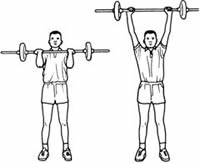Overhead Pressing Strategy
Update: here’s another blast from the past. Dating back to November 2, 2007, this was one of my first posts on overhead presses and it still rings true.
The four most important exercises for any serious weight lifter to obsess about are the squat, deadlift, bench press, and overhead press. Today, I am going to discuss how to properly perform a standing overhead press (aka shoulder press or military press), and a push press. Both motions are obviously used to push objects overhead. Clearly, overhead pressing is not only extremely functional but is fundamental in helping to build a firm athletic base regardless of your fitness goals.
I am going to be using a barbell in this explanation, but it can be performed with any reasonable object. First of all, load a bar appropriately and bring the weight to the front your shoulders. You can either clean the weight from the floor like an Olympic weightlifter or you can load the bar at the desired height in a squat rack.
Shoulder Press or Overhead Press

The first step is to take the bar with an overhand grip with palms facing forward and with your feet shoulder width apart or slightly wider, and knees only slightly bent. The starting position begins with the bar being held over the upper chest.
Take a deep breath and hold it. Now begin pressing the weight overhead with the elbows situated directly underneath the wrists. Make sure that your arms are as close to vertical as possible when pressing overhead. Also, be sure to contract those abdominals while trying not to allow too much arching in the lower back.
Once you hit the toughest part of the lift, begin forcefully exhaling through pursed lips, as if letting air out of a tire. This will ensure a safe spine position and help you push the weight through the full range of motion. Remember to pause just short of locking out your elbows and reverse the direction bringing the bar back to the upper chest while inhaling appropriately.
Military Press
Many definitions of the military press are identical to the shoulder press or overhead press, except that the feet are specifically positioned in a narrower stance. I’m guessing your foot position would be just inside shoulder width. This makes the exercise slightly harder.
Push Press
The push press can be done with more weight then the military press because you will be using your legs (the push) to help propel the press.
To execute a proper push press, start with the bar in the same position as the military press, on your upper chest. Now bend your knees at a 30-45 degree angle, about a 1/3 to 1/4 squat. Now use your legs and hips to squat the weight up, and use the momentum of the push to start the press.
The momentum from the push combined with the strength of your press should move the bar through the midway sticking point and hopefully to the top of your range of motion. Once again, pause just short of lockout and allow the bar to descend back to your upper chest. Be sure to catch the bar with slightly bent knees to preserve the health of your knees and lower back.
How to Use Overhead Presses
Switch off between these two exercises as your overhead press. Use the military press for a month to establish proper form and discover your starting weight. Then use the push press for a month with 110% or more of the weight you used for your military press.
For example, I might military press 135 x 8 but I might push press 185 x 8. When you switch back to the military press, you will probably be several pounds stronger than when you did them last. Overhead pressing should be part of your core exercises along with squat, bench, and deadlift. Give it a try and you will surely appreciate the results.
Less Intense Options
I don’t recommend them, but there are also some good shoulder exercises you can do if you can’t complete a shoulder press or a push press. They are good solutions shoulder training exercises, but all standing barbell overhead presses are superior.
Seated Military Press: Many gyms have a military press station in which you can sit on a bench, unrack the bar from the hooks, military press to your hearts content, and either drop the bar on the rails that run parallel to you, or re-rack it on the hooks.
Standing Dumbbell Shoulder Press: Grab two dumbbells and clean them up to shoulder level. Press each dumbbell from shoulder level to just short of full extension above the head. To avoid putting too much strain on the lower back, consider using an alternating pressing motion: left arm, right arm, left arm, right arm, etc…
Seated Dumbbell Shoulder Press: Sit on a bench with a dumbbell in each hand, lying one on each knee. Use your legs to pop the dumbbells up to shoulder level one at a time. Keeping your feet flat on the floor and driving through the heels, press both dumbbells from shoulder level to just short of full extension above the head. Lower the weights under control.
Tags: pressing, shoulders, weightlifting











Hey there,
First off, this blog has been a great resource for me on my fitness journey. So thanks for that!
Secondly, I think someone mentioned this in an other post about shoulder workouts, but I must say I can’t recommend handstand push-ups enough when it comes to a great compound workout for the shoulders.
A few months ago I realized I was avoiding workouts because I didn’t have time to get to the gym. So I developed a routine that involved exercises I could do easily at home. A gymnast friend recommended handstand pushups as a good upper-body exercise. Now I’m the kind of guy who can’t even do a kartwheel, so I didn’t think this would work for me, but I gave it a try anyway. Every workout I would throw myself up against the wall and try to lower my head to the ground without collapsing on the floor. At first it sucked, but a couple of weeks later I was popping out 5 rep sets pretty comfortably. I’m what you would call a hard gainer, most specifically when it comes to my shoulders and pecs, and for the first time in my life I started to develop the kind of developed, strong upper body shape I’d always tried to achieve. My arms also got huge thanks to their secondary role in lifting my entire bodyweight up and down for multiple reps. The combination of pullups and handstand pushups has done more for my physical transformation than any other exercises I could care to name. Sure it’s scary to hang out upside down with nothing but your arms between you and a concussion, but it gets great results.
Anyway, thanks again for the info you make available on this blog. I’ll keep reading.
That’s a great review of handstand push ups. I also highly recommend them.
If you really want to hammer your shoulders, keep your elbows out to the side, bring the bar down to anywhere between your shoulders and eye level, then press upward with no assistance from the lower body. Work sets of 5 x 5 with 60 seconds of rest between sets. If you are able to complete 5 x 5 at a given weight, then add more weight for your next workout. If you can’t complete 5 x 5 at a given weight, stay with it until you can, then add more weight.
I have been using a seated military press for a long time, and I do have a lack of shoulder development, but is there a way to do the standing military press and overhead press with a weak/bad lower back? Should I use a belt of a full back brace for it or will that negate some of the effectiveness of the lift? Thanks
If you have a bad lower back you might consider going to PT to strength it safely, or learn how to PT it yourself. If you have a weak lower back then I suggest you start using exercises to strength it, like bent over rows, deadlifts, good mornings, and squats. There are also bodyweight exercises you can use like The Superman. You can use a belt in the meantime to help keep your back safe.
Awesome blog. My wife and I are Personal Trainer in Bighton, UK. Sherry has her own blog called https://www.fitfoxy.biz. Are you interested in swopping guest blog appearances?
I am always interested in swapping guest posts. Although I don’t always have the time to write them, I always accept quality guest posts on Project Swole. Contact me with your ideas.
I like the variation where the elbows are in front of the bar, like they would be coming out of a front squat and into a push press or a push jerk. As the bar goes up, the elbows go underneath.